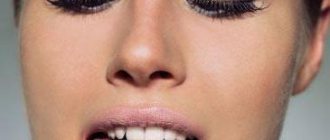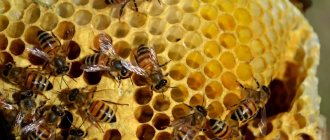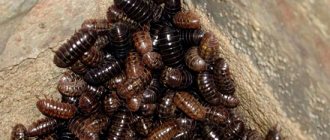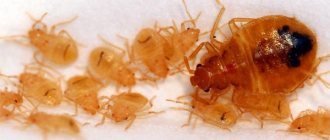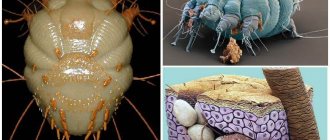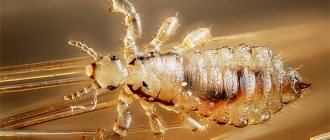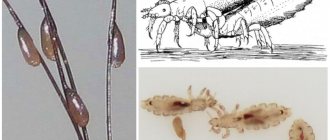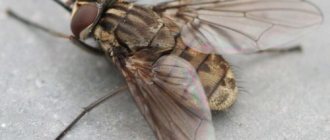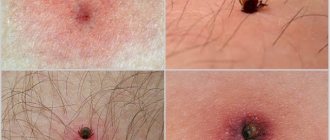Lice are parasites that live on the hairy parts of the human body and feed on his blood. There are many versions of who is most susceptible to lice infection and where they come from. However, many of them are far-fetched and not true.
It’s worth understanding what causes lice infection and how you can protect yourself and your loved ones.
The main reasons for the appearance
Lice are insects that cannot fly, jump, run fast, or even move long distances (an insect can easily cover a maximum of 30–40 cm). But at the same time, almost anyone can become infected with lice, even if they follow all the rules of hygiene and live in comfortable conditions. If we talk about the reasons for the appearance of nits and lice, we can name one real one - parasites are transmitted through contact between a healthy person and an infected person.
Another thing is that infection can occur through direct contact (for example, when people hug, touching each other’s hair) or when using contaminated things or objects (for example, a person with lice combed his hair, and then a healthy person uses the same comb and gets lice and nits).
Using someone else's comb
When people cite uncleanliness as the cause of head lice, people are most often mistaken. It has been proven that parasites feel more comfortable on a clean body. The only thing that speaks in support of this version is that parasites are attracted by the smell of sweat, so a body that has been unwashed for a long time can also be called an indirect cause of the appearance of lice.
How to treat pediculosis?
Remedies for lice are offered by both folk and traditional medicine. Folk offers to treat hair
- wormwood decoction
- boiled beets,
- mint juice,
- parsley juice,
- cranberry juice,
- kerosene,
- vinegar,
- dust and tar oils.
The latter, however, can be purchased at the pharmacy; they are very popular in the fight against parasites. Kerosene and vinegar demonstrate their effectiveness by 90%, but do not have the best effect on the general condition of the hair. Modern pharmaceuticals offer special over-the-counter products to combat lice - shampoos, sprays, aerosols. You can also buy hellebore water at the pharmacy - this is a cheap and effective way to get rid of lice.
Applying any product to the hair leads to the death of parasites, but it is also necessary to comb them out of the hair. You need to cut your hair short or shave it bald. Pharmacies also sell special combs with closely spaced teeth; they are indicated for use after each hair treatment with an anti-lice agent.
Treatment of head lice is very individual - a remedy that is effective in one case may be ineffective in another. It is advisable to carry out treatment under the supervision of the attending physician, who will also recommend effective sanitary measures.
Pediculosis has always remained an extremely unpleasant disease and should be feared. However, there is no need to be ashamed of this disease; timely measures to combat the parasite leave it no chance of survival.
Methods of transmission of head lice
It is very difficult to protect yourself from lice, since there are many places where you can get infected and ways of infection. The most common:
- upon contact with a carrier of parasites;
- when using other people's things (hygiene items, clothing, bed linen, towels);
- in public places (beauty salons, baths, gyms).
From person to person
Since lice cannot jump or fly from one head to another, in order for them to appear in a healthy person, close contact with an infected person is required. This may happen:
- during hugs, sleeping together;
- when being in a cramped room with a large number of people (public transport during rush hour, crowded elevator, barracks, crowded queue);
- during sexual intercourse.
Head lice can end up in your hair even after visiting a movie theater, provided that there is a person with lice in the next seat.
According to research, head lice in adults is diagnosed less often than in children.
Lice in children
Children attending preschool and educational institutions are the category most susceptible to lice infection. This is explained by the fact that children interact with each other more closely than adults, and in addition, due to their age, they do not yet understand the importance of preventive measures and do not follow the necessary rules. The source of lice are kindergartens, schools, summer camps, and playgrounds.
So, what can cause children to have head lice:
- close contact with an infected child (during games, hugs, joint selfies, fights);
- when exchanging combs, hair accessories, hats;
- when using one towel;
- sleeping on someone else's pillow.
A baby can become infected with lice even while playing with an infected child in the same sandbox. Lice and nits can be in the sand and get into your hair with it.
Using other people's things
Other people's things are another source where lice on a person's head come from. Insects can live up to 2 days without food, and nits do not need food at all. So parasites may well remain on things after they have been used by an infected person, and then transfer from them to the hair of a healthy person.
A person may develop lice after using:
- combs, hairpins, hoops or any other hair accessories;
- towels;
- headdress, scarf;
- shower or pool caps.
Using a towel
You can become infected by using a sun lounger on the beach on which a person infected with lice had previously lain, or by trying on clothes in a store that have lice or nits on them.
Hair salons and swimming pools
Lice in an adult and a child may appear after visiting:
- beauty salon, massage salon, hairdresser;
- baths, saunas;
- swimming pool, pond with standing water.
The reasons for this may be insufficient disinfection of the tools used by the master and the premises. And in the case of pools and ponds, parasites that are washed off the head of the infected person and are in the water can get on the hair (lice can swim and can live in water for several days). So, even when entering a clean-looking pool, it is better to protect yourself by wearing a swimming cap.
Do lice spread from animals to humans?
Lice infest not only people, but also animals. In particular, in pets – dogs and cats. However, you should not worry about the risk of infection.
Lice are species-specific insects; each species lives only on one species of animal. So cat and dog lice do not pose a threat to humans, just as human lice are not dangerous for mustachioed and furry household members.
Can they appear on their own?
There are many versions about where human lice come from initially, but in practice they are all wrong:
- Lice do not exist under or on human skin in a state of suspended animation, waiting for the right opportunity to become active.
- Predisposition to head lice is not transmitted genetically.
- Negative emotions do not provoke the appearance of parasites.
Lice only appear after contact with an infected person or his things.
How are lice transmitted from person to person?
The dangerous thing is that the causes of lice are so commonplace that anyone can become infected with lice. It doesn’t matter what kind of life a person leads and how much he maintains hygiene. Lice can be everywhere, so you can never predict their appearance. Where do lice in human hair come from and how can they be transmitted?
How are parasites transmitted?
- In kindergartens, when children play and interact with each other;
- Using the same comb or pillow with an infected person;
- Water procedures in the bathroom and sauna without changing the water. Lice can live in liquid for a sufficient amount of time, so after bathing an infested person, the lice will float in the water for some time. They can easily end up on your hair.
- Using hats with a person who is infected with lice.
- Places where there are a large number of people, especially on public transport. Lice can easily crawl onto another person's hair.
Many people notice parasites after sexual intercourse has occurred. Typically, pubic lice are located only on the pubic area and armpits. If parasites occur, it is necessary to begin treatment so as not to worsen the situation.
Pediculosis pubis
Pubic lice live mainly in the groin area or armpits. The reasons for the appearance of pubic lice are the same - contact with an infected person. Taking into account the peculiarities of the location of the disease, in most cases, infection occurs during sexual intercourse.
Many cases of illness and the appearance of lice are observed after visiting pools and ponds. This is because pubic lice swim better than other species and live longer in water.
What else causes pubic lice:
- using someone else's towel;
- sleeping in the same bed with an infected person;
- visiting a public bath or sauna (it is especially dangerous to sit on a bench without a sheet or bedding);
- trying on underwear in a store on a naked body.
Visiting a public sauna
False stereotypes about lice
Nervous lice
There are different versions of the appearance of lice in humans, some of which are completely implausible. There is an opinion that lice can appear from nerves. This cannot be, because “from the nerves” means out of nowhere, and this is already in the realm of fantasy. And since we don’t believe in the supernatural, we understand that lice can only crawl from another person. Even if a person is constantly under stress, this cannot be the reason for the appearance of lice. It must be said that this stereotype is very widespread, and such opinions can be heard not only from villagers, but also from city residents. But nothing can appear out of nowhere, and lice are no exception.
Weakening of the body
There is another misconception that lice are located under human skin, and begin to become active only when the body weakens. Perhaps the reason for this misconception was the fact of the existence of subcutaneous mites. These insects actually exist, and their presence causes severe itching, but they have absolutely nothing to do with lice. Nevertheless, opinions are sometimes expressed that the bulges of the skull are nothing more than subcutaneous clusters of lice. Lice leave their shelter when a person becomes nervous, as his body temperature rises at this time. Of course, such statements should not be taken seriously.
Not so simple
But here it must be said that the smell of sweat is indeed very attractive to lice. When under stress, people actually sweat, so the appearance of lice in a person may well be associated with a stressful state, but still they do not appear on their own. In principle, attracted by the smell of sweat, a louse can appear on a person, but this is only possible under conditions of very close contact with the infected person.
The “nervous” theory of the occurrence of pediculosis can also be explained by the fact that pediculosis is confused with one of the dermatological diseases that may well develop due to nervousness.
In this case, a person’s skin is constantly itching, which makes him want to scratch all the time, but this has nothing to do with insects. Therefore, there is no need to make hasty conclusions if you feel itching. In this case, it is better to contact a specialist. But it is not always convenient to advertise your illness, then they use a comb, which can be purchased at every pharmacy. It is better to comb your hair with a comb over a white sheet of paper, on which insects, if they exist, will certainly be found.
Pick it up from cats and dogs
It is also impossible to get lice from animals. Of course, lice can parasitize cats and dogs, but these are completely different insects that would never live on a human body. There are also chicken lice, which also have nothing to do with human lice.
Parasitic nits themselves cannot be transmitted from an infected person to a healthy person, because nits are only insect eggs, deprived of the ability to move. Nits can only get on another person with fallen hair or when combing.
When on public transport, you need to be especially wary of becoming infected with body lice, which live in the folds of clothing and crawl onto the human body only to feed. With close contact, a body louse can easily move from person to person.
Preventive measures
It is impossible to protect yourself 100% from the appearance of parasites, but preventive measures will help reduce the likelihood of infection:
- do not use other people’s combs, hair accessories, or towels;
- change and wash underwear and bed linen in a timely manner;
- do not wear other people's hats and scarves;
- collect long hair in a braid or bun;
- on the train and in the hotel, sleep only on clean linen;
- thoroughly clean the bathroom after strangers;
- limit contact with potential carriers of parasites.
If we are talking about a child, we must not forget about regular examinations of his head for the presence of lice.
Examination of the child
Why might lice appear again?
Sometimes it happens that lice appear again and again, it seems that they live on the body constantly, despite the treatment. There could be several explanations for this:
- constant contact with a lice carrier (for example, if one of the household or close friends with whom the person often meets is sick with lice, but does not know about it);
- incorrect treatment (not all parasites were destroyed, or nits remained on the body, and after a while the person is bothered by lice emerging from the eggs).
In this case, you need to pay close attention to your immediate environment and carry out repeated, full-fledged treatment.


